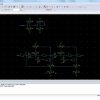Proposed Title :
Low Power CMOS 130nm Glitch Energy Reduction and SFDR Enhancement Techniques with Binary Weighted Current Steering DAC
Proposed System:
- Design the Technology CMOS 130 nm
- Low power Concuption
Software implementation:
- Tanner EDA
₹20,000.00 Original price was: ₹20,000.00.₹10,000.00Current price is: ₹10,000.00.
Source : VHDL
Abstract:
This brief proposes a glitch reduction approach by dynamic capacitance compensation of binary-weighted current switches in a current-steering digital-to-analog converter (DAC). The method was proved successfully by a 10-bit 400-MHz pure binary-weighted current steering DAC with a minimum number of retiming latches. The experiment results yield very low-glitch energy during major carry transitions at output.
List of the following materials will be included with the Downloaded Backup:
Proposed Title :
Proposed System:
Software implementation:
₹25,000.00 Original price was: ₹25,000.00.₹16,000.00Current price is: ₹16,000.00.


₹10,000.00 Original price was: ₹10,000.00.₹6,000.00Current price is: ₹6,000.00.
Copyright © 2024 Nxfee Innovation.
Reviews
There are no reviews yet.